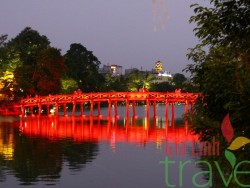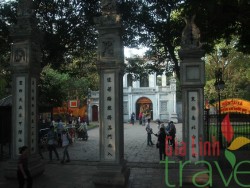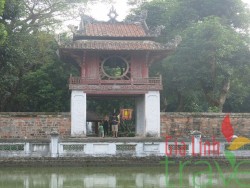Hanoi Temples
Hanoi temples


Quan Thanh Temple

Temple of Literature
Tran Quoc Pagoda
The original pagoda was constructed within the 6th century and is considered the oldest in Vietnam. It was based on the bank of the Pink River by King Ly Nam De who named it Khai Quoc (National Founder). A lot later, it was moved to its present website beside Hanoi’s Ho Tay (West) Lake throughout the reign of King Le Kinh Tong (1600-1618) and renamed Tran Quoc (National Defense). The present constructing is the results of major renovations in 1815, but one in every of its effigies dates again to the early seventeenth century.
Within the garden, there’s a Pipal Tree (ficus religious, however identified all through history because the Bodhi tree) seemingly grown from a chopping of the original tree where Buddha sat and gained enlightenment.
Hoe Nhai Pagoda
This pagoda was based in 1020 by a Chinese Buddhist monk named Trong Dien. The ruling monarch at that time had persecuted Buddhist monks. Dien described the Buddhist philosophy for him, and he relented.
Inside, a statue of Dien reveals him sitting on the Kings back, symbolizing the beneath standing between them. The inside framework of the building and the altars are all normal in hardwood and are very attractive.
One Pillar Pagoda.
Close to what is now the Ho Chi Minh Museum, the One Pillar (or One Tree) Pagoda overlooks a small pond. It was built by Emperor Ly Thai Tong after a dream in which the Goddess of Mercy handed him a male child on a lotus flower. He created the small wood pagoda to resemble a lotus blossom to commemorate the delivery of his long-awaited heir.
Sadly, the unique was destroyed throughout the conflict with the French. The present building is a replica erected the 12 months after the colonists had been finally expelled in 1954.
Lien Phai Pagoda
This pastel colored multi-tiered pagoda stands in a pleasant backyard hidden in a labyrinth of alleys leading off Bach Mai Street slightly below the city centre to the south. It’s set amongst nice and tranquil gardens subsequent to the principle building of worship. The pagoda was based by one of the Nguyen Lords in the early 18th century who picked up a rock resembling a lotus root in his again garden. Considering this a sign from Buddha, he converted his palace into the pagoda.
A visit additionally offers a chance to venture into the maze of tiny alleys off the main roads the place nearly all of Hanoi’s residents reside, and where foreigners are a terrific rarity.
Quan Thanh Pagoda
This spectacular pagoda was founded in the course of the reign of King Ly Thai To (1010-1028), and is situated beside Truc Bach Lake. It’s ornately decorated and stands before a nice courtyard shaded by banyan trees. Inside, there may be an imposing four-ton bronze statue of the God of the North cast in 1677, together with his attendant spirits, a snake and a tortoise – clearly a Taoist symbol.
Tay Ho Pagoda
Named after the lake it sits beside, the pagoda occupies an outstanding place on a tongue of land projecting into the water. It’s dedicated to Thanh Mau, the Mother Goddess, who appeared on the lake as a pretty woman, smiling and reciting poetry to a fisherman, then vanished.
It is one of Hanoi’s most popular pagodas, attracting many worshippers on the first and fifteenth of every lunar month. It’s additionally a pleasant place to visit, notably as part of a visit around the lake by boat – it has its personal landing stage.
Lang Pagoda
Situated in Hanoi’s suburbs, the Lang Pagoda offers a possibility to see a semi-rural area, yet one more of Hanoi’s many faces. It was built throughout the reign of Emperor Ly than Tong (1128-1138). Entry is via an historical concrete and picket gateway flanked by stone elephants. The courtyard encloses an octagonal pavilion. For visitors, it gives a peaceable setting where local college students wish to learn and paint and previous people enjoy relaxing in the shade of the trees.
Chem Temple
Chem. Temple is in Thuy Phuong village close to the southern financial institution of the Thang Long Bridge. The temple is devoted to Ly than, who was dispatched to assist the primary emperor of the Chi’ in Dynasty in China and married his daughter throughout the second century BC. It’s believed that the Chem. Temple was constructed around the seventh or 8th century on the positioning of Ly than’s residence. The present temple right now was erected within the 19th century.
The temple contains two gilded wood statues of Ly Than and his spouse sculpted in 1888. It’s a relaxing place, with glorious views of the Purple River
Giong Temple
Giong Temple is in Gia Lam District, once the home of a tenth-century legendary hero referred to as Thanh Going. It’s located in a peaceable rural area throughout the Crimson River to the east of Hanoi city centre. The location truly consists of two temples.
The Dong Temple is large and impressive. In line with local legend, it was constructed by King Ly Thai immediately after the king moved to Thang Lengthy in 1010. It now has two prayer halls, a rear palace and, unusually, a theatre built on the front pond for water puppet reveals, all of which have been constructed in 19th century.
The Mau Temple was initially inbuilt 1693 on the outer dyke and is dedicated to Thanh Dong’s mother. Close by is a previous backyard once owned by Thanh Dong’s mother? It contains a stele bearing a legend. Apparently, a large trampled upon the vegetable patch and left a footprint. The subsequent day, Dong’s mom positioned her foot within the giant print, turned pregnant and gave birth to Thanh Dong.
Dong Nhan Temple
Situated in central Hanoi, this temple pays homage to the Trung sisters, Trung Trac and Trung NHI, Vietnamese heroines who led a riot to drive out the Han invaders in AD 40.
The Dong Nhan Temple was originally constructed on the Red River bank within the twelfth century, but the bank collapsed in 1819 and the temple was moved to its current location. A local legend tells that one night time in early February, two statues were discovered floating in the Pink River in 1142 and have been introduced ashore by villagers. King Ly Anh Tong was advised and ordered a temple devoted to the statues to be built on the spot.
The two statues stand on the rear of the temple and wear hibiscus hats with their hands rising as much as their faces attended by twelve statues of female generals on every side.
Thu Le Temple (Kneeling Elephant Temple)
The temple derives its title from two kneeling elephants guarding the gate.
Positioned in Hanoi’s Thu Le botanical backyard, this temple was built in the Ly Thai Tong Dynasty (1028-54) near West Lake, and was devoted to Linh Lang,
Son of King Ly Thai Tong.
In line with legend, the King’s spouse was confronted by a dragon, and became pregnant. When the child was born, he had dragon scales and lights twinkling like pearls on his chest. As an adult, he led the army to expel invaders. The grateful king wanted to abdicate in his favour, however Linh Lang refused. He was reworked into a black dragon entangled around a stone slab and disappeared into West Lake. The king ordered a temple to be built on the site.
The Thu Le Temple still comprises two bronze statues and a large concave stone slab. It’s in a horny wooded panorama beside a pond, a calm and harmonious ambiance conducive to contemplation.
Quan Su Pagoda
The Quan Su is Hanoi’s largest and most popular pagoda. It was first erected on land in An Tap village near the southern gate of Thang Long (the outdated title for Hanoi).
Originally a small Buddhist pagoda positioned near the 15th century Quan Su house used to obtain international envoys and ambassadors, the pagoda finally grew to become the headquarters of the Tonkin Buddhist Association. Over the years, the pagoda has been restored and expanded many times.
Bach Ma (White Horse) Temple in the Old Quarter
In keeping with legend, in the ninth century, King Ly Thai to be struggling to build the Hanoi Citadel, however the partitions kept collapsing due to the marshy sub-soil. Bach Ma (White Horse), who was the spirit of Thang Long, appeared within the guise of a builder and instructed the King find out how to create foundations that may assist the masonry. The King was grateful, and ordered the constructing of a pagoda dedicated to Bach Ma. A statue of the horse stands beside the altar.
The current structure was constructed in the 18th century, and is typical of Hanoi’s pagodas. It’s hidden away within the Outdated Quarter, and blends in nicely with its bustling streets. There’s even a shop constructed into the partitions to the left of the entrance
